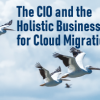Business Transformation Requires Transformational Leaders
Leadership and teaming skills are front and center in times of rapid change. Meet today’s constant disruption head on with expert guidance in leadership, business strategy, transformation, and innovation. Whether the disruption du jour is a digitally-driven upending of traditional business models, the pandemic-driven end to business as usual, or the change-driven challenge of staffing that meets your transformation plans — you’ll be prepared with cutting edge techniques and expert knowledge that enable strategic leadership.
Subscribe to Arthur D. Little's Culture & Leadership Newsletter
Insight
The Smart Supply Chain
Things that are manufactured need to be handled in the supply chain all the way from basic components down to the finished product arriving at the customer’s doorsteps or shop shelves. But as those “things” become smarter, the physical value chains and information processes converge.
Transformation leaders need to balance the pressures of delivering incremental value in short sprints to the customer or consumer to demonstrate value with the need to ensure that they leverage the best possible enterprise resources and align with broader corporate goals and strategies.
In this on-demand webinar, Cutter Senior Consultant Gustav Toppenberg explores how a powerful digital backbone can facilitate rapid innovation and responsiveness — keys to successful digital transformation.
Communication is difficult. It turns out that this approach of opening minds to the potential benefits of opposing ideas can be very valuable. Time and again we find that the best approach is at neither end of the scale, but instead at a “sweet spot” that balances the forces and harvests the best aspects of either end of the scale.
CIOs and their teams must make sure the business case for cloud migration is aligned with key business priorities, and that their migration plan addresses a few fundamental key success factors.
The Next-Generation Business Architect: The Bright Future Ahead
In this Executive Update, we explore some of the truths about the business architect role, potential focuses for the role, career path options, and what the future holds for a discipline that finds itself at the heart of business and technology change.
HALO: The Human Augmented Learning Organization
This Executive Update discusses the thinking behind employing artificial intelligence (AI) in an organization through “augmentation.” It presents a case study on how a superregional bank implemented a cognitive contact center by using an AI framework called HALO — Human Augmented Learning Organization — and showcases the meaning of “AI as a practice” within an organization.
Srinivas Garapati explores important philosophies and the mindset behind Agile and Lean. He starts with the thinking patterns required to be successful. He then considers the nature of an Agile organization and finishes with strategies for organizational design.















